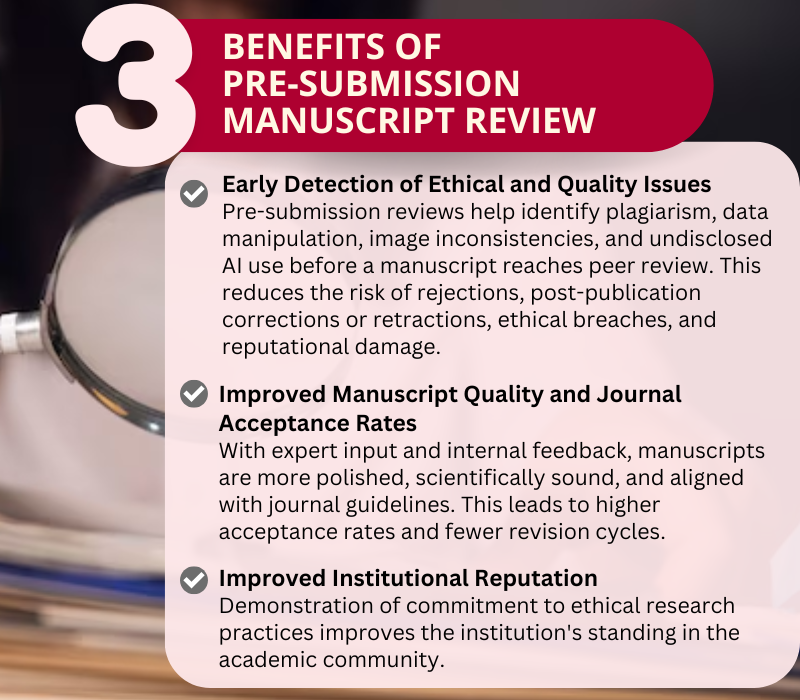Better Safe Than Retracted: The role of pre-submission review in upholding research integrity

The scientific community is grappling with growing concerns around research misconduct, reproducibility crisis, and increasing public skepticism. High-profile retractions, data manipulation scandals, and the rise of paper mills have further eroded trust in scholarly publishing. As a result, the burden on institutions have intensified, especially in the context of rising publication volumes and undisclosed use of AI in manuscript preparation.
The Mounting Pressure on Institutions
As submission volumes grow and AI-generated content becomes more prevalent (often without disclosure), journals are implementing stricter screening processes. The legal and reputational ramifications of misconduct are now falling on affiliated institutions, making a proactive commitment to research ethics not just advisable, but essential. Furthermore, funding agencies and regulatory bodies now expect institutions to have robust mechanisms in place to ensure research integrity.
In early 2024, the Dana-Farber Cancer Institute, affiliated with Harvard Medical School, came under intense scrutiny when a British blogger, Sholto David, flagged 57 papers published between 1997 and 2017 for alleged data and image manipulation. Following an investigation, several of the papers were either corrected or retracted. This incident sparked several debates around the reputational impact of such cases on academic institutions and raised critical questions about the adequacy of internal oversight—even at prestigious organizations. Additionally, it spotlighted the ethical responsibilities of co-authors and principal investigators to ensure data integrity at the earliest stages of research.
Role of Pre-Submission Reviews
Several studies confirm the growing role of plagiarism and data fabrication to retractions. For example, a descriptive study analyzing the causes of retraction revealed that 32.7% manuscripts were retracted due to plagiarism and 32.5% due to data processing issues. Many of these instances could have been prevented through robust pre-submission reviews. In a separate analysis, researchers examined a few samples of scientific papers with signs of GPT-generated content on Google Scholar. The findings revealed that roughly two-thirds of them had been produced either completely or partly using ChatGPT, without disclosure.
To address these risks, institutions can implement pre-submission reviews as a proactive “gatekeeping” mechanism. This additional layer of review, conducted before manuscript submission, detects potential issues firsthand, ensuring that research outputs meet ethical and quality standards.
Key benefits include of pre-submission reviews include:

By institutionalizing these checks and balances at the pre-submission stage, organizations not only prevent errors and misconduct but also reinforce a culture of accountability. It is most effective when early-career researchers are trained in ethical writing, data integrity, and responsible AI use, as they are the primary content creators and most prone to unintentional errors. Embedding such education into graduate and doctoral programs can normalize good practices from the outset, making pre-submission reviews a “quality control mechanism”, improving quality and adherence to publisher policies.
Moreover, by identifying and correcting issues upstream, pre-submission reviews can help reduce reviewer burden and alleviate peer review delays. This approach aligns with the growing expectations from funders, publishers, and the public, while preserving the credibility of the academic enterprise.
Introducing Enago’s 3-in-1 Manuscript Review Pack
To support institutions in this endeavor, Enago offers a comprehensive 3-in-1 Manuscript Review Pack:
1. Plagiarism Report:
- Ensures compliance with publishing norms by thorough plagiarism detection by scanning content against both open access and pay-walled content. This helps in flagging reuse of text, whether intentional or accidental.
- Assists researchers in understanding citation gaps or improper paraphrasing that may otherwise go unnoticed.
2. AI Content Detection Report:
- Flags AI-generated text from a wide range of LLM models like ChatGPT, Bard, Bing Chat, Gemini, Llama, etc. and provides a precise overview with score.
- Aids researchers and institutions in aligning with evolving disclosure requirements from publishers and funders.
- Provides actionable insights for revising or contextualizing AI-assisted sections, supporting transparency and responsible authorship.
3. Technical Check Report
- Reviews 25+ key criteria including manuscript structure, compliance to the journal and ethical guidelines, authorship, image integrity, language, references, etc. to ensure the manuscript is structured, formatted, and compliant with journal requirements.
- Enhances submission readiness by improving clarity, formatting consistency, and presentation quality.
- Validates authorship details and contributions, helping prevent authorship disputes.
Together, these three Enago reports serve as a multi-layered defense system—not just for individual authors but for entire institution. By integrating this service into their workflows, institutions can proactively address and rectify potential issues before submission, safeguarding their credibility and supporting their researchers in achieving publication success.
Your institution’s next retraction could cost millions—or worse, your credibility! By partnering with the global service providers like Enago and implementing rigorous pre-submission reviews, institutions can uphold the highest standards of research integrity, ensuring that their contributions to science are both credible and respected.









